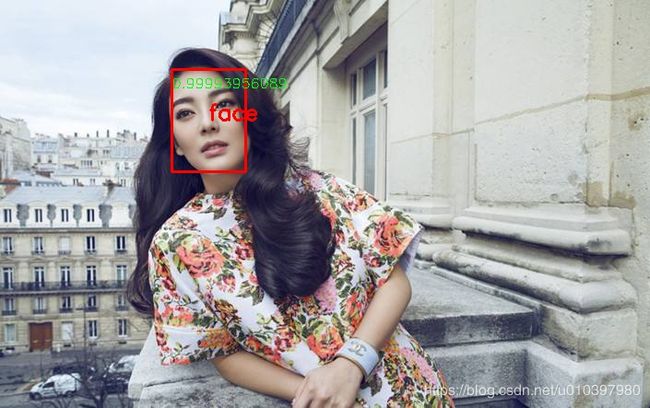使用yolov3-tiny训练一个人脸检测器
春节放假回家时,在北京西乘坐高铁进站时发现,现在出现了很多自助进站验证对pos机器,主要是对身份证和个人的照片进行匹配,判断是不是同一个人,无需人工check了,省时省力。春节在家没事干,想起了人脸识别的事情,感觉挺好玩,就试着先训一个人脸检测模型。这里的识别效果并不会和目前最先进的模型进行对比,只是觉得好玩测试一下流程而已。
一、人脸检测数据的准备
![]() 我使用的是widerface数据集(http://mmlab.ie.cuhk.edu.hk/projects/WIDERFace/index.html)
我使用的是widerface数据集(http://mmlab.ie.cuhk.edu.hk/projects/WIDERFace/index.html)
分别下载训练集、验证集及标注的label 人脸边框的位置,得到wider_face_split.zip,WIDER_train.zip,WIDER_val.zip,解压后得到wider_face_split、WIDER_train、WIDER_val文件夹。wider_face_split为标注的边框,里面label保存为txt格式,但是yolov3使用的是voc数据格式的数据集。因此需要对每张图像生成新的VOC数据格式的xml标签。
下面的代码可以把txt的标签转为xml,代码名字为txt_2_xml.py,注意修改txt_label和img_path的路径,然后执行 python2 txt_2_xml.py
#coding:utf-8
import os
import cv2
from xml_writer import PascalVocWriter
#txt_label = "wider_face_split/wider_face_val_bbx_gt.txt"
#img_path = "WIDER_val/images"
txt_label = "wider_face_split/wider_face_train_bbx_gt.txt"
img_path = "WIDER_train/images"
def write_xml(img, res):
img_dir = os.path.join(img_path, img)
print img_dir
img = cv2.imread(img_dir)
shape = img.shape
img_h, img_w = shape[0], shape[1]
writer = PascalVocWriter("./", img_dir, (img_h, img_w, 3), localImgPath="./", usrname="wider_face")
for r in res:
r = r.strip().split(" ")[:4]
print r
x_min, y_min = int(r[0]), int(r[1])
x_max, y_max = x_min + int(r[2]), y_min + int(r[3])
writer.verified = True
writer.addBndBox(x_min, y_min, x_max, y_max, 'face', 0)
writer.save(targetFile = img_dir[:-4] + '.xml')
with open(txt_label, "r") as f:
line_list = f.readlines()
for index, line in enumerate(line_list):
line = line.strip()
if line[-4:] == ".jpg":
print "----------------------"
#print index, line
label_number = int(line_list[index + 1].strip())
print "label number:", label_number
#print line_list[index: index + 2 + label_number]
write_xml(line_list[index].strip(), line_list[index+2: index + 2 + label_number])
xml_writer.py为
#!/usr/bin/env python
# -*- coding: utf8 -*-
import sys
from xml.etree import ElementTree
from xml.etree.ElementTree import Element, SubElement
from lxml import etree
import codecs
XML_EXT = '.xml'
ENCODE_METHOD = 'utf-8'
class PascalVocWriter:
def __init__(self, foldername, filename, imgSize,databaseSrc='Unknown', localImgPath=None , usrname = None):
self.foldername = foldername
self.filename = filename
self.databaseSrc = databaseSrc
self.imgSize = imgSize
self.boxlist = []
self.localImgPath = localImgPath
self.verified = False
self.usr = usrname
def prettify(self, elem):
"""
Return a pretty-printed XML string for the Element.
"""
rough_string = ElementTree.tostring(elem, 'utf8')
root = etree.fromstring(rough_string)
return etree.tostring(root, pretty_print=True, encoding=ENCODE_METHOD).replace(" ".encode(), "\t".encode())
# minidom does not support UTF-8
'''reparsed = minidom.parseString(rough_string)
return reparsed.toprettyxml(indent="\t", encoding=ENCODE_METHOD)'''
def genXML(self):
"""
Return XML root
"""
# Check conditions
if self.filename is None or \
self.foldername is None or \
self.imgSize is None:
return None
top = Element('annotation')
if self.verified:
top.set('verified', 'yes')
user = SubElement(top , 'usr')
# print('usrname:' , self.usr)
user.text = str(self.usr)
folder = SubElement(top, 'folder')
folder.text = self.foldername
filename = SubElement(top, 'filename')
filename.text = self.filename
if self.localImgPath is not None:
localImgPath = SubElement(top, 'path')
localImgPath.text = self.localImgPath
source = SubElement(top, 'source')
database = SubElement(source, 'database')
database.text = self.databaseSrc
size_part = SubElement(top, 'size')
width = SubElement(size_part, 'width')
height = SubElement(size_part, 'height')
depth = SubElement(size_part, 'depth')
width.text = str(self.imgSize[1])
height.text = str(self.imgSize[0])
if len(self.imgSize) == 3:
depth.text = str(self.imgSize[2])
else:
depth.text = '1'
segmented = SubElement(top, 'segmented')
segmented.text = '0'
return top
def addBndBox(self, xmin, ymin, xmax, ymax, name, difficult):
bndbox = {'xmin': xmin, 'ymin': ymin, 'xmax': xmax, 'ymax': ymax}
bndbox['name'] = name
bndbox['difficult'] = difficult
self.boxlist.append(bndbox)
def appendObjects(self, top):
for each_object in self.boxlist:
object_item = SubElement(top, 'object')
name = SubElement(object_item, 'name')
try:
name.text = unicode(each_object['name'])
except NameError:
# Py3: NameError: name 'unicode' is not defined
name.text = each_object['name']
pose = SubElement(object_item, 'pose')
pose.text = "Unspecified"
truncated = SubElement(object_item, 'truncated')
if int(each_object['ymax']) == int(self.imgSize[0]) or (int(each_object['ymin'])== 1):
truncated.text = "1" # max == height or min
elif (int(each_object['xmax'])==int(self.imgSize[1])) or (int(each_object['xmin'])== 1):
truncated.text = "1" # max == width or min
else:
truncated.text = "0"
difficult = SubElement(object_item, 'difficult')
difficult.text = str( bool(each_object['difficult']) & 1 )
bndbox = SubElement(object_item, 'bndbox')
xmin = SubElement(bndbox, 'xmin')
xmin.text = str(each_object['xmin'])
ymin = SubElement(bndbox, 'ymin')
ymin.text = str(each_object['ymin'])
xmax = SubElement(bndbox, 'xmax')
xmax.text = str(each_object['xmax'])
ymax = SubElement(bndbox, 'ymax')
ymax.text = str(each_object['ymax'])
def save(self, targetFile=None):
root = self.genXML()
self.appendObjects(root)
out_file = None
if targetFile is None:
out_file = codecs.open(
self.filename + XML_EXT, 'w', encoding=ENCODE_METHOD)
else:
out_file = codecs.open(targetFile, 'w', encoding=ENCODE_METHOD)
prettifyResult = self.prettify(root)
out_file.write(prettifyResult.decode('utf8'))
out_file.close()
class PascalVocReader:
def __init__(self, filepath):
# shapes type:
# [labbel, [(x1,y1), (x2,y2), (x3,y3), (x4,y4)], color, color, difficult]
self.shapes = []
self.filepath = filepath
self.verified = False
try:
self.parseXML()
except:
pass
def getShapes(self):
return self.shapes
def addShape(self, label, bndbox, difficult):
xmin = int(bndbox.find('xmin').text)
ymin = int(bndbox.find('ymin').text)
xmax = int(bndbox.find('xmax').text)
ymax = int(bndbox.find('ymax').text)
points = [(xmin, ymin), (xmax, ymin), (xmax, ymax), (xmin, ymax)]
self.shapes.append((label, points, None, None, difficult))
def parseXML(self):
assert self.filepath.endswith(XML_EXT), "Unsupport file format"
parser = etree.XMLParser(encoding=ENCODE_METHOD)
xmltree = ElementTree.parse(self.filepath, parser=parser).getroot()
filename = xmltree.find('filename').text
try:
verified = xmltree.attrib['verified']
if verified == 'yes':
self.verified = True
except KeyError:
self.verified = False
for object_iter in xmltree.findall('object'):
bndbox = object_iter.find("bndbox")
label = object_iter.find('name').text
# Add chris
difficult = False
if object_iter.find('difficult') is not None:
difficult = bool(int(object_iter.find('difficult').text))
self.addShape(label, bndbox, difficult)
return True
二、yolov3的darknet目标检测框架
在darknet官网上下载(https://pjreddie.com/darknet/)并安装darknet,保证可以对VOC数据集进行训练。然后把VOC数据替换为我们的人脸数据。修改配置文件参数,并进行训练,这里我只用yolov3-tiny训练了14万次,模型在这里链接: https://pan.baidu.com/s/109LU1GlCA-1o-l0CpZ0ZIw 提取码: mw5i
三、检测人脸
我们可以使用darknet训练好的.weights模型对图像进行人脸检测。使用python接口调用模型,预测的代码在这里(https://github.com/zhangming8/face_detect_yolov3/tree/init)对源码进行了少量修改,执行python2 detect_all_img.py可以对图像进行预测,预测方法有3种:1.可以直接预测本地的图像 2. 可以用cv2调用摄像头再进行预测 3. 可以对本地对视频进行预测
结构保存在results文件夹里,下面是对本地图像对预测结果:



